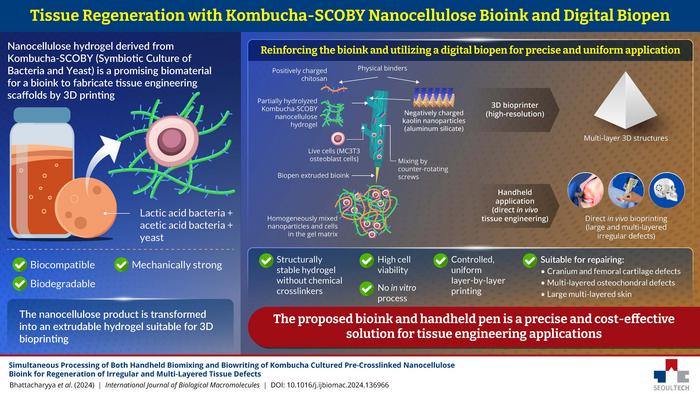
In the ever-evolving field of tissue engineering, a remarkable breakthrough has emerged from Korea, where researchers have harnessed the potential of Kombucha SCOBY-derived nanocellulose to formulate a groundbreaking bioink. This innovative creation, developed by a team led by Professor Insup Noh of Seoul National University of Science and Technology, demonstrates extraordinary promise in the realm of personalized medicine. By leveraging this unique bioprinting technology, they are poised to transform the treatment paradigm for various medical conditions, particularly those involving wounds and tissue defects.
The essence of this new methodology lies in utilizing a bioink derived from the symbiotic culture of bacteria and yeast found in Kombucha. This material not only provides a sustainable alternative to traditional scaffolding options but also supports the growth and integration of human cells. This advancement could lead to a shift in how complex tissue structures—such as skin, cartilage, and even organs—are engineered in the lab and applied to patients.
The new bioink is complemented by a compact, handheld device known as the ‘Biowork’ biopen. This tool allows practitioners to apply the bioink with precision directly onto affected areas, ensuring that treatment can be tailored to the specific contours and complexities of individual wounds. The digitization of the application process heralds a new era in tissue repair, enabling healthcare providers to execute highly personalized treatment plans that cater directly to the needs of their patients.
A significant aspect of the bioink’s composition is its reinforcement with chitosan and kaolin, both known for their biocompatibility and structural integrity. The chitosan particles impart a positive charge, while the kaolin particles are negatively charged. This interplay creates an electrostatically stabilized gel that guarantees optimal consistency for 3D bioprinting. Such advancements not only enhance the mechanical properties of the bioink but also ensure that it maintains its structural integrity during the application and healing processes.
The preparation of this bioink involves a meticulous blending of nanocellulose, chitosan, kaolin, and live cells, which occurs within the biopen. The biopen employs two counter-rotating screws to ensure that the components are uniformly mixed, resulting in a homogeneous bioink solution that can be administered via precise needle application. This method significantly streamlines the process of treating complex injuries, enabling the creation of self-supporting structures that can withstand the challenges of in vivo application.
Moreover, the biopen’s capabilities extend beyond just direct application. When attached to a 3D printer, it can produce intricate, multilayered structures that boast exceptional resolution, including complex forms such as bifurcated tubes and pyramidal shapes. This flexibility not only benefits the immediate treatment of defects but also opens avenues for future applications in reconstructive surgery and advanced medical therapies.
The researchers envision the bioink and biopen technology as particularly advantageous in emergency settings, where quick and effective treatment is essential. In situations where time is of the essence, the capability to mix and apply bioink on-site could significantly enhance outcomes for patients with severe wounds or complex tissue injuries. This one-step process reduces the need for traditional culture methods that require extended laboratory processing, often delaying crucial interventions.
Importantly, this technology aligns perfectly with the growing demand for sustainable healthcare solutions. By utilizing a biodegradable material derived from Kombucha, this innovation not only addresses immediate medical needs but also considers the long-term impacts on environmental sustainability. The potential to fabricate biological materials that are both effective in healing and kind to the planet presents a promising frontier in the quest for sustainable medical technologies.
The implications of this research extend beyond the laboratory. As the medical community becomes increasingly reliant on personalized medicine approaches, technologies like the bioink developed by Prof. Noh’s team are likely to gain prominence in clinical applications. The ability to bioprint tissues that meet the exact specifications of each patient’s unique anatomy presents an unparalleled opportunity to improve surgical outcomes and patient satisfaction.
This research, which has been documented in a recent publication in the International Journal of Biological Macromolecules, marks a significant advancement in the field of bioprinting and regenerative medicine. With an article title straightforward in its directness, the real story lies in the potential this research holds to better the lives of countless patients suffering from tissue injuries.
The development of this bioprinting technology is receiving considerable attention, not just for its innovative methods but for its possibilities in the broader context of medical ethics and patient care. As discussions surrounding personalized medicine continue to evolve, the urgent need for cost-effective, adaptable solutions in tissue engineering remains clear. This bioink and direct application technology stand at the intersection of necessity and innovation, ready to redefine how medical professionals approach wound care and tissue regeneration.
In summary, the confluence of bioprinting technology utilizing Kombucha-derived nanocellulose, combined with the advanced capabilities of the biopen, creates a robust framework for future exploration and implementation in clinical settings. Researchers and medical professionals alike are brimming with excitement about the transformations that lie ahead in the fields of tissue engineering and regenerative medicine.
As the world looks towards advancements in healthcare technologies, the journey initiated by Professor Noh and his team stands as a beacon of hope and innovation, suggesting that the future of medicine might be at our fingertips—quite literally.
Subject of Research: Cells
Article Title: Simultaneous processing of both handheld biomixing and biowriting of kombucha cultured pre-crosslinked nanocellulose bioink for regeneration of irregular and multi-layered tissue defects
News Publication Date: 28 October 2024
Web References: https://doi.org/10.1016/j.ijbiomac.2024.136966
References: DOI: 10.1016/j.ijbiomac.2024.136966
Image Credits: Credit: Professor Insup Noh from Seoul National University of Science and Technology
Keywords
Tissue engineering, Chondrogenesis, Sustainable development, Biomolecular structure, Tissue repair, Chemical engineering.
Tags: bioprinting technology applicationscomplex tissue structure engineeringcustomized medical treatmentshandheld bioprinting devicesKombucha SCOBY nanocellulose bioinkpersonalized medicine advancementsregenerative medicine developmentsSeoul National University research breakthroughssustainable scaffolding materialstissue defect treatmentstissue engineering innovationswound healing solutions





